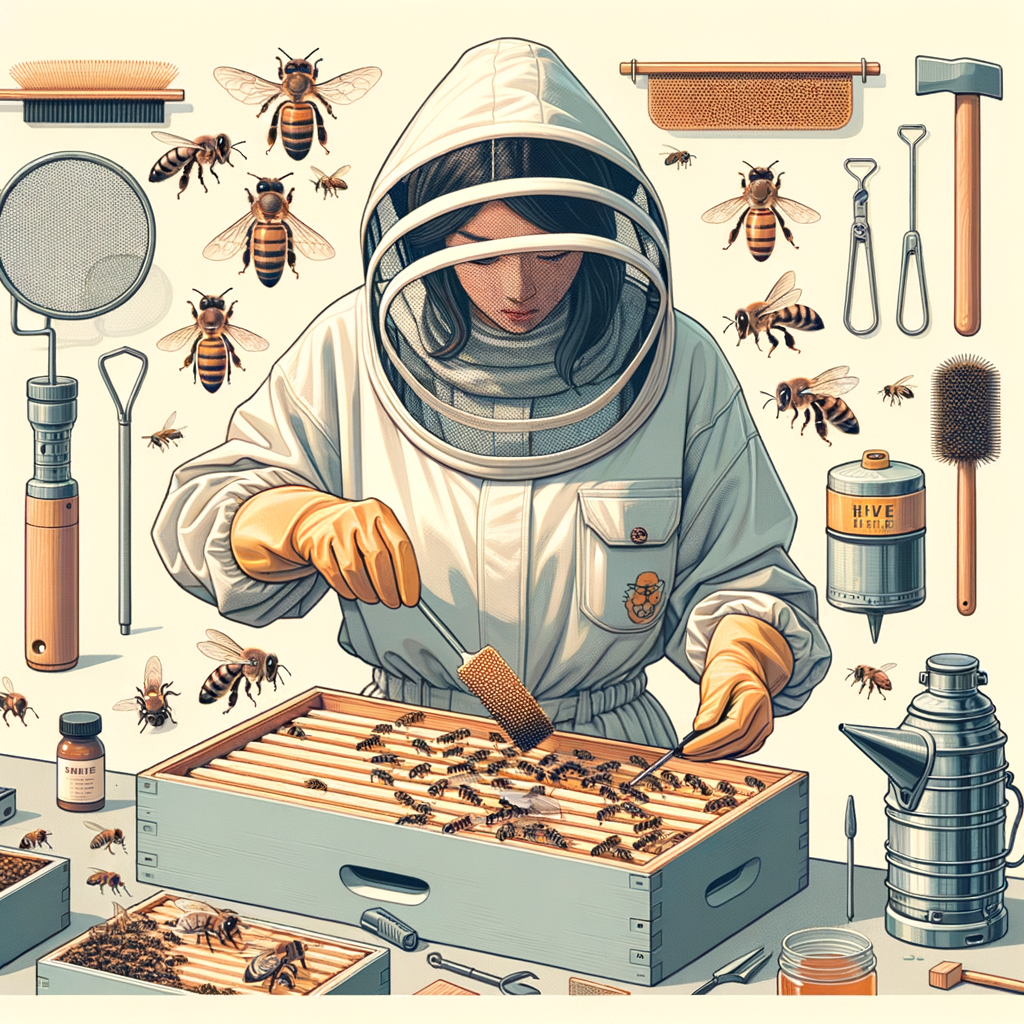
Introduction to Beekeeping Basics
Welcome to the fascinating world of beekeeping! This hobby is not only rewarding but also plays a crucial role in our ecosystem. Let’s dive into the basics of beekeeping, its importance, and why it can be a beneficial hobby for you.
- Understanding the Importance of Beekeeping
- Exploring the History of Beekeeping
- Why Beekeeping is a Beneficial Hobby
Beekeeping, also known as apiculture, is vital for our planet. Bees are key pollinators, which means they help plants reproduce. Without bees, many of the foods we enjoy, like fruits and vegetables, would become much less abundant and more expensive. In fact, it’s estimated that one-third of the food we consume each day relies on pollination mainly by bees. So, by becoming a beekeeper, you’re contributing to the health of our environment.
Beekeeping has a long and rich history. It dates back to ancient times, with evidence of honey hunting in rock paintings from 8,000 years ago. The Egyptians were known to keep bees in straw hives as early as 2400 B.C., and they used honey not only for food but also for medicinal and religious purposes. Over the centuries, beekeeping methods have evolved, but the fascination with these industrious creatures and the sweet nectar they produce remains the same.
Beekeeping can be an incredibly rewarding hobby. Not only does it help the environment, but it also provides you with fresh honey, which is a natural sweetener and has numerous health benefits. It’s a hobby that connects you with nature and can be quite therapeutic. Plus, if you become proficient, you might even be able to turn it into a profitable business!
Now that we’ve covered the basics, let’s delve deeper into the world of beekeeping. In the following sections, we’ll provide a comprehensive guide for beginners, discuss essential beekeeping equipment, and share some useful techniques and tips. So, stay tuned and get ready to embark on your beekeeping journey!
A Comprehensive Beekeeping Guide for Beginners
For those who are new to the world of beekeeping, it can seem like a daunting task. However, with the right knowledge and understanding, it can be a rewarding and fulfilling hobby. Let’s start by understanding the basics of beekeeping.
Understanding Beekeeping
Beekeeping, also known as apiculture, is the practice of maintaining bee colonies in man-made hives. This is done by humans for the production of honey and other products like beeswax, propolis, and royal jelly. Beekeeping also helps in pollination of crops. But before we dive into the details, let’s understand the bees themselves.
- Introduction to bee species
- Understanding the life cycle of bees
- Exploring the social structure of a bee colony
There are over 20,000 known species of bees in the world. However, the most common species used in beekeeping is the Western honey bee (Apis mellifera). They are known for their ability to produce honey and their gentle nature. Other species used in beekeeping include the Eastern honey bee (Apis cerana) and the stingless bees (Meliponini tribe).
The life cycle of a bee consists of four stages: egg, larva, pupa, and adult. The queen bee lays the eggs, which hatch into larvae in about three days. The larvae are fed by worker bees and after about six days, they become pupae. After another 12-20 days, the pupae emerge as adult bees. The entire process, from egg to adult, takes about 21-24 days for worker bees and drones, while it takes 16 days for a queen bee.
A bee colony is a highly organized society, with each bee having a specific role. The queen bee is the mother of all bees in the colony and her main role is to lay eggs. The worker bees, which are female, do all the work in the hive like cleaning, feeding the larvae, and collecting nectar and pollen. The drones, which are male bees, have only one job, and that is to mate with the queen. The social structure of a bee colony is fascinating and is key to the success of a beekeeping endeavor.
Understanding the basics of beekeeping is the first step towards becoming a successful beekeeper. In the next section, we will delve into the essentials of beekeeping, including choosing the right location for a beehive, understanding the seasons and beekeeping, and the essential beekeeping equipment.
Essentials of Beekeeping
Before we delve into the specifics of beekeeping, it’s crucial to understand the essentials. These are the fundamental aspects that every aspiring beekeeper must grasp to ensure a successful beekeeping journey.
- Choosing the right location for a beehive
- Understanding the seasons and beekeeping
- Essential beekeeping equipment
The location of your beehive can significantly impact your bees’ health and honey production. Bees need a safe, quiet place with access to fresh water and a variety of flowers. Avoid areas with heavy foot traffic or loud noises, as these can stress the bees. Also, consider the direction of the wind and the amount of sunlight the hive will receive. A good location can make all the difference in your beekeeping experience.
Just like other creatures, bees have a life cycle that is influenced by the seasons. In the spring, bees are busy collecting nectar and pollen as they prepare to expand their colony. Summer is the peak of honey production. In the fall, bees start to slow down and prepare for winter. During winter, bees stay in the hive and live off their stored honey. Understanding these seasonal changes can help you provide the best care for your bees.
Having the right equipment is crucial for successful beekeeping. Here are some of the essentials:
| Equipment | Description |
|---|---|
| Beehive | This is the home for your bees. It’s where they will live, produce honey, and raise their young. |
| Bee suit and gloves | These will protect you from bee stings when you are handling the hive. |
| Smoker | This tool emits smoke that calms the bees, making it easier for you to inspect the hive. |
| Hive tool | This is a multipurpose tool used for opening the hive, separating the frames, and scraping off excess wax or propolis. |
Understanding these essentials will provide a solid foundation for your beekeeping journey. Remember, beekeeping is a learning process. Don’t be discouraged if you make mistakes along the way. With patience and perseverance, you’ll become a successful beekeeper in no time.
Beekeeping Equipment Essentials
As we delve deeper into the world of beekeeping, it’s crucial to understand the essential equipment required. These tools not only make the process easier but also ensure the safety of both the beekeeper and the bees.
Essential Beekeeping Tools
Here are some of the must-have tools for every beekeeper:
- Bee Suit and Gloves
- Hive Tool and Bee Brush
- Smoker and Fuel
First and foremost, a bee suit and gloves are critical for your protection. A bee suit is a full-body suit made of light material that prevents bee stings. It usually comes with a veil to protect your face. Gloves, on the other hand, protect your hands while handling the hive and bees.
A hive tool is a versatile piece of equipment used for various tasks like prying apart frames and scraping off excess wax or propolis. A bee brush is a gentle way to move bees off the frames without hurting them.
A smoker is a device used to produce smoke which calms the bees and makes them less aggressive. The fuel can be anything from wood chips to pine needles. Remember, the smoke should be cool, not hot, to avoid harming the bees.
These tools form the backbone of beekeeping operations. They not only make the process smoother but also ensure the safety of the beekeeper and the bees. Beekeeping can be a rewarding hobby or a profitable business, but like any other venture, it requires the right tools and equipment.
| Equipment | Use |
|---|---|
| Bee Suit and Gloves | Protection from bee stings |
| Hive Tool and Bee Brush | Handling and cleaning the hive |
| Smoker and Fuel | Calming the bees |
In conclusion, beekeeping is a fascinating activity that requires a certain level of commitment and the right equipment. With these tools in your arsenal, you are well on your way to becoming a successful beekeeper.
Beekeeping Techniques and Tips
Mastering the art of beekeeping requires a deep understanding of various techniques and tips. In this section, we will explore some of these practices to help you become a successful beekeeper.
Beekeeping Practices Explained
There are several practices that every beekeeper should be familiar with. These include inspecting your beehive, harvesting honey, and managing pests and diseases. Let’s delve into these practices.
- Inspecting your beehive
- Harvesting honey
- Managing pests and diseases
Regular inspection of your beehive is crucial to ensure the health of your bees. This involves checking the frames for signs of disease, assessing the queen’s health, and ensuring there’s enough food for the bees. Remember, a healthy hive is a productive hive.
Harvesting honey is one of the most rewarding aspects of beekeeping. The best time to harvest honey is when the bees have capped the honeycomb with wax. Use a bee brush to gently remove the bees from the frames before extracting the honey. Always leave enough honey for the bees to survive the winter.
Bees are susceptible to various pests and diseases. Regular inspection can help you identify any potential threats early. If you notice any signs of disease, such as deformed wings or discolored larvae, take immediate action. Similarly, if you notice pests like mites or beetles, use approved treatments to control them.
By mastering these beekeeping practices, you can ensure the health and productivity of your hive. Remember, beekeeping is a journey of learning and discovery. So, keep exploring, keep learning, and enjoy the sweet rewards of your hard work.
Conclusion: The Joy of Beekeeping
As we draw to a close on our comprehensive guide to beekeeping, it’s important to take a moment to reflect on the journey we’ve taken together and the joy that beekeeping can bring into our lives.
- Reflecting on the benefits of beekeeping
- Encouragement for continued learning and practice
Beekeeping is more than just a hobby; it’s a lifestyle that brings numerous benefits. From the tangible rewards of honey and beeswax to the intangible benefits of relaxation and connection with nature, beekeeping enriches our lives in many ways. It also contributes to the environment by supporting the pollination of plants, which is crucial for our food supply. According to the U.S. Department of Agriculture, bees help to pollinate approximately 75% of the fruits, nuts, and vegetables grown in the United States.
Beekeeping is a journey of continuous learning and practice. Each day brings new experiences and challenges, and each season presents new opportunities for growth and improvement. As the famous beekeeper Lorenzo Langstroth once said, “Beekeeping is like any other skill. It takes time to learn, but the rewards are worth it.”
As we conclude, remember that the joy of beekeeping comes not only from the honey you harvest but also from the journey of learning, growing, and contributing to the environment. So, keep learning, keep practicing, and keep enjoying the sweet rewards of your efforts. Happy beekeeping!








